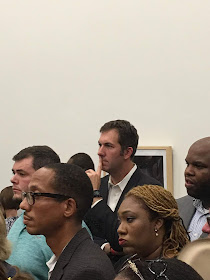 |
| 2019 Abell Report: "An Inquiry" |
The lack of interest in the new study is surprising because the fiscal difficulties of Baltimore County are all over the news and could provide an interesting new twist to the merger discussion: What if the usual assumption, that a merger would be a bonanza for the City and a bane for the County is wrong? What if the beneficiary of a merger wouldn't be the City but the County? What if, in the long run, at least, the County has less of a fiscal perspective than the City?
How such a reverse scenario could come about was, in part, the topic of my recent article about the County fiscal woes which pointed to the major reasons why County expenses rise and County revenues decline. (Fiscal realities are hitting home in Baltimore County).
It was only a matter of time until Baltimore County would face a fiscal reckoning not unlike the one the City has known for a long time. The writing has been on the wall for years: Most central Maryland counties outperformed Baltimore City and County when it came to household income, increases in property values, educational attainment, job growth and school performance. This are the very same metric which have put the City under pressure for decades and forced the shrinking of Maryland's largest incorporated city. With shrinking incomes, populations and property values came the steady rise of City taxes, until they were almost twice as high as those in the County. For a long time it was enough for the County to have low taxes and "not being the City". (Blog article)To a great extent, with growth slowing and the infrastructure aging, the County is now facing the same problems that the City has faced for many years. Running out of space for new greenfield development and being fleeced by adjacent counties with more development space left, the County now has to retool its revenue base in much the same way as the City has done so for decades. What's in the toolbox?
- development of infill and brownfields and adaptive re-use of abandoned structures
- to densification on already developed areas instead of more sprawl or cornfields
- provision of lifestyle choices which attract young, well educated people
- the increase of taxes and fees
The lack of interest in the merger report is also surprising, because much of the subtext of the past Baltimore City-County relationship has been based on race. One can suspect that much of the aversion of even thinking about a merger is still racially tainted. In a time when working through the legacy of race discrimination has become a daily topic from monuments to black-face, one would think that the loaded issue of City-County relations should be no exception.
In spite of the changed demographic, fiscal and political realities, which even challenges traditional assumptions about who would win or loose, a merger of City and County following the model of the cities in the Abell study, still seems to be a political third rail and not very likely to happen. Hence the widespread shrugging of shoulders when the topic comes up again.
But make no mistake, the winds have changed significantly: Neither is the County any longer free of the ills that plagued the City for so long (sinking property values, sinking student achievements, higher poverty) nor, looking further in the future, is the City so much worse off than the County. In fact, the City has enjoyed a healthy influx of young new talent, an increase in its tax base and a slew of new development and jobs (even though, by the numbers population still shrank slightly).
The three new Democratic Executives in the counties surrounding the City (Baltimore County, Anne Arundel County and Howard County) all indicated that they intend to work much more closely with Baltimore's Mayor. Olszewski, Ball and Pittman realize that they share many issues because they know no boundaries, from water and sewer, to transportation and crime.
Baltimore City's recent vote for cleaner air, potentially forcing the incinerator out of business, would have an impact on all the jurisdictions, especially Baltimore County which incinerates as much waste as the City. The ever growing Port of Baltimore is planning to expand into Tradepoint Atlantic in Baltimore County. All Counties share the City's interest in resolving the East Coast freight bottleneck of the low tunnel under Howard Street which doesn't all double stacking containers. All are affected by the ancient B&P tunnel under West Baltimore which forces all "high speed" Acela trains to crawl through at 30mph.
 |
| Baltimore County looks like a wrench holding the City |
In spite of the changed demographic, fiscal and political realities, which even challenges traditional assumptions about who would win or loose, a merger of City and County following the model of the cities in the Abell study, still seems to be a political third rail and not very likely to happen. Hence the widespread shrugging of shoulders when the topic comes up again.
But make no mistake, the winds have changed significantly: Neither is the County any longer free of the ills that plagued the City for so long (sinking property values, sinking student achievements, higher poverty) nor, looking further in the future, is the City so much worse off than the County. In fact, the City has enjoyed a healthy influx of young new talent, an increase in its tax base and a slew of new development and jobs (even though, by the numbers population still shrank slightly).
The three new Democratic Executives in the counties surrounding the City (Baltimore County, Anne Arundel County and Howard County) all indicated that they intend to work much more closely with Baltimore's Mayor. Olszewski, Ball and Pittman realize that they share many issues because they know no boundaries, from water and sewer, to transportation and crime.
Baltimore City's recent vote for cleaner air, potentially forcing the incinerator out of business, would have an impact on all the jurisdictions, especially Baltimore County which incinerates as much waste as the City. The ever growing Port of Baltimore is planning to expand into Tradepoint Atlantic in Baltimore County. All Counties share the City's interest in resolving the East Coast freight bottleneck of the low tunnel under Howard Street which doesn't all double stacking containers. All are affected by the ancient B&P tunnel under West Baltimore which forces all "high speed" Acela trains to crawl through at 30mph.
Regional collaboration in our area has a long history. It started a 100 years years ago when the region's juridisctions built the current water delivery and distribution system. Today Baltimore City’s Department of Public Works provides drinking water to 1.8 million people daily throughout Baltimore City and parts of Baltimore County and portions of Anne Arundel, Carroll, Harford and Howard Counties. The three reservoirs treatment centers are regional in reach. Interestingly, Baltimore County managed to charge its residents lower rates than Baltimore City, an inequity which won't work any longer. The County's water and sewer rates don't cover their rising costs, now that the ever extended pipes are starting to age and fall apart, just as they have done for a while in the City.
All three Counties are served by MTA's bus and rail transit system and all three complain about the service and mull over options of running a locally operated system. It is obvious, that only together could they stem a big task like a local transit agency. BGE's gas and electric system is regional and so are Comcast and Verizon's cable services or the mobile phone services of most national carriers. The University of Maryland has facilities in City and County, but community colleges remain split. In all those topics, the entities the local jurisdictions deal with are so much bigger and powerful, that only speaking with one voice can amplify their stand. The Baltimore Metropolitan Council, theoretically the place where the locals coordinate needs to become much more robust to have an effect.
Once in a while one can see how crime doesn't know boundaries when Baltimore County police chases criminals deep into the City or vice versa. Yet, the two departments are strictly separate and so is most everything else from schools to parks and recreation. To whose benefit?
Of course, the history of redlining and exclusionary zoning which fueled urban flight and created the deep segregation and inequities that characterized City and County for a long time and resulted in the high concentrations of poverty in the City and the lack of affordable housing in the Counties. (Baltimore County doesn't have any public housing) is a volatile topic. But the affordable housing crisis cries out for a regional solution, just as the 2015 regional Opportunity Collaborative had demanded when the Baltimore unrest was still fresh on everybody's mind.
 |
| Then candidate for County Executive Olszewski listens to Mayor Pugh at a meeting in the City. (photo: Philipsen) |
It doesn't take a rocket scientist to realize, that it doesn't make a lot of sense that services to the people in the region should be segregated in this way, be it education, housing or police, especially if each side produces less and less satisfactory results, sometimes for different reasons: For example, County schools are often overcrowded, City schools close for lack of students.
Back in the 1990s Minnesota politician Myron Orfield began to paint future of the "inner ring suburbs" in dire colors with a series of maps. He had been invited by the Citizens Planning and Housing Association, a City activist organization founded right after WW II which looked at housing and began then to study how regional collaboration could help to create more opportunities.
Orfield is the guru of regional tax base sharing, invented in the 7-county region of the twin-city region of Minneapolis St Paul where Orfield was a state politician. In that system each of the participants squirrel 40% of the tax gains they get from new development or new companies into a common pot, 60% they keep. The money from the common pot is than being distributed in a regionally controlled manner, accounting for population and needs. By most accounts, this system has been a success, considerably reducing extreme inequities. It presents another solution to collaboration than a full merger.
Orfield is the guru of regional tax base sharing, invented in the 7-county region of the twin-city region of Minneapolis St Paul where Orfield was a state politician. In that system each of the participants squirrel 40% of the tax gains they get from new development or new companies into a common pot, 60% they keep. The money from the common pot is than being distributed in a regionally controlled manner, accounting for population and needs. By most accounts, this system has been a success, considerably reducing extreme inequities. It presents another solution to collaboration than a full merger.
Baltimore City and County should take a closer look at the Abell study, especially at the incremental levels the three sample cities collaborated before they did a complete merge. One key difference is that those cities were all along inside a county, like all major cities in the US, except Baltimore and St Louis, which are euphemistically called "independent cities". Before the full merge the partner which would later merge had different forms of governance, tax rates and forms of representation. But some shared key functions such as education or police. Just imagine, how much a combined City-County police force would change the current debate about the future of the two individual departments.
The time when it was enough for Baltimore County to occasionally send a check to the City for having a great symphony, an opera and all the major museums, is over. In a time where entire metro regions compete globally for educated, young talent, regional pooling, planning and coordination of housing, economic development, sustainability, environmental protection, and transportation is a matter of survival. The time where it was enough to run a Ponzi scheme where Peter would rob Paul to keep the system going doesn't work any longer. Any region needs a healthy core to prosper as a whole. Time for Peter and Paul to join forces, even if it isn't a full merger.
Klaus Philipsen, FAIA
read also on this blog:



































